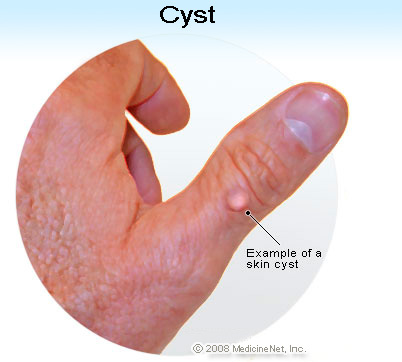Cysts

Menstuff® has information on
Cysts:
What is a
cyst?
What
are the causes of a
cyst?
What
are the types of
cysts?
What
are the signs and symptoms of a cyst, and how are they
diagnosed?
What is
the treatment for a
cyst?
Cysts
At A Glance
Related Information: Wikipedia

What is a cyst?
A cyst is a closed, saclike structure that contains
fluid, gas, or semisolid material and is not a normal part
of the tissue where it is located. Cysts are common and can
occur anywhere in the body in people of any age. Cysts vary
in size; they may be detectable only under a microscope or
they can grow so large that they displace normal organs and
tissues. The outer wall of a cyst is called the capsule.
What are the causes of a
cyst?
Cysts can arise through a variety of processes in the
body, including
- "wear and tear" or simple obstructions to the flow of
fluid,
- infections,
- tumors,
- chronic inflammatory conditions,
- genetic (inherited) conditions,
- defects in developing organs in the embryo.
Most cysts arise due to the types of conditions listed
above and are only preventable to the extent that the
underlying cause is preventable.
What are the signs and symptoms of a
cyst, and how are they diagnosed?
Sometimes you can feel a cyst yourself when you feel an
abnormal "lump." For example, cysts of the skin or tissues
beneath the skin are usually noticeable. Cysts in the
mammary glands (breasts) also may be palpable (meaning that
you can feel them when you examine the area with your
fingers). Cysts of internal organs such as the kidneys or
liver may not produce any symptoms or may not be detected by
the affected individual. These cysts often are first
discovered by imaging studies (X-ray, ultrasound,
computerized tomography or CAT scan, and magnetic resonance
imaging or MRI). Cysts may or may not produce symptoms,
depending upon their size and location.

What are the types of cysts?
There are hundreds of types of cysts that can arise in
the body. Here are some of the more well-known types of
cysts:
- Cysts in the breast which are part of benign
proliferative ("fibrocystic") disease (fibrocystic breast
disease)
- Ovarian cysts, including dermoid cysts, a specific
type of ovarian tumor that often contains cysts and other
tissues
- Cysts within the thyroid gland
- Baker cyst (popliteal) behind the knee
- Ganglion cysts of the joints and tendons
- Cysts of the glands within the eyelid, termed
chalazions
- Sebaceous cysts of the small glands in the skin
- Epidermal cysts of the skin, sometimes known as
epidermal inclusion cysts
- Bartholin cysts, enlargement of small glands near the
vaginal opening
- Pineal cysts, cysts within the pineal gland of the
brain
- Pancreatic cysts are collections of fluid within the
pancreas. Some pancreatic cysts are true cysts that are
lined by a cells that secrete fluid. Other pancreatic
cysts are pseudocysts and do not contain specialized
lining cells.
- Polycystic kidney disease, an inherited condition in
which the kidneys contain multiple cysts
- Tarlov cysts, also known as meningeal or perineural
cysts, located in the sacrum, the fused bones at the base
of the spine.
The majority of cysts are benign, but some may produce
symptoms due to their size and/or location. Rarely, cysts
can be associated with malignant tumors (cancers) or serious
infections. If you're concerned about any abnormal swelling
or lump, talk to your doctor. He or she can recommend
appropriate diagnostic tests to determine whether a cyst is
present and the cause of the cyst.
What is the treatment for a
cyst?
The treatment for a cyst depends upon the cause of the
cyst along with its location. Cysts that are very large and
result in symptoms due to their size may be surgically
removed. Sometimes the fluid contained within a cyst can be
drained, or aspirated, by inserting a needle or catheter
into the cyst cavity, resulting in collapse of the cyst.
Radiologic imaging may be used for guidance in draining
(aspirating) cyst contents if the cyst is not easily
accessible.
Surgical removal of a cyst is sometimes necessary. If
there is any suspicion that a cyst is cancerous, the cyst is
generally removed by surgery or a biopsy is taken of the
cyst wall (capsule) to rule out malignancy. In certain
cases, aspirated fluid from a cyst is examined under a
microscope to determine if cancer cells are present in the
cyst.
If a cyst arises as part of a chronic medical condition
(for example, in polycystic ovary syndrome or fibrocystic
breast disease), treatment is generally directed at the
underlying medical condition.
Cysts At A Glance
- Cysts are common, closed saclike structures that
contains fluid, gas, or semisolid material.
- There are hundreds of types of cysts.
- Cysts can be located in all areas of the body.
- Superficial cysts may be felt as an abnormal "lump."
Cysts of internal organs may not be noticed and may or
may not produce symptoms.
- A number of different processes can result in cyst
formation, including blockage of the flow of fluids,
infection, trauma, tumors, congenital defects, and
chronic inflammatory conditions.
- The majority of cysts are benign, but certain cases
can be associated with malignant tumors.
Source: www.medicinenet.com/cysts/article.htm

* * *

Contact
Us |
Disclaimer
| Privacy
Statement
Menstuff®
Directory
Menstuff® is a registered trademark of Gordon Clay
©1996-2023, Gordon Clay
|